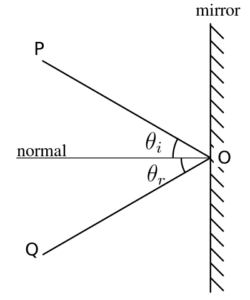Many things can happen to light at an interface between two media, such as the interface between air and a mirror. If the light changes direction so that it stays in the same medium that it came from, it is called reflection. When light travels through the air to the interface with a mirror, the light is bounced back and stays in the air, thus it is reflected. The law of reflection states that the incident angle is the same as the reflected angle and is illustrated below:

Here, the light originates from point P. It travels to the mirror with an incident angle of θi and hits the mirror at point O. It is reflected at the reflected angle θr and travels to point Q. According to the law of reflection, θi = θr. This is called specular reflection, and it usually happens on flat, polished surfaces, like mirrors. On rough surfaces, this doesn’t always happen. The light can be scattered at other angles. This is called diffuse reflection. Most of what humans see comes from diffuse reflections.





